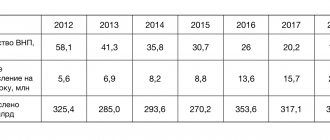What are taxes in simple words
Taxes are mandatory payments that taxpayers are required to transfer to the state, region or municipality upon the occurrence of a certain event. Such an event is called a “taxable object”. A definite event is an abstract formulation that does not always mean an event in its usual meaning. For example, such events could be: receipt of income by an individual, ownership of a vehicle, receipt of profit by an organization, etc. It is worth noting that taxes are the main source of budget formation. Thus, the lion's share of budget revenues comes from tax revenues. The idea of taxes is that these funds finance the activities of the entire state. With local taxes, taxpayers pay for road maintenance, sewer repairs, and other local issues.
Types of tax rate
The tax rate is the amount of tax that falls on a unit of taxation (ruble of income, hectare of land, and so on).
There are four types of tax rates:
| Type of tax rate | Description |
| Firm bet | This is the tax rate per unit of taxation, which is set regardless of total income. With this tax rate, the owner of ten hectares of land with an income of 20,000 rubles per 1 hectare will pay the same as the owner of 100 hectares with an income of 1 million rubles. |
| Proportional rate (or income tax) | This is a tax consisting of a fixed percentage of income, regardless of its size. That is, with a proportional tax rate of 3%, a person with an income of 20,000 rubles. and a person with an income of 1 million rubles will pay the state 3% of their income. In Russia, since 2001, this tax has been 13%. |
| Progressive rate | This is a rate that increases as taxable income increases. That is, a person whose income is 20,000 rubles will pay 3% of his income, and a person whose income is 1 million rubles will pay more (depending on the ratios established by law), for example, 15%. |
| Regressive rate | This is a rate that decreases as taxable income increases. At this rate, a person with an income of 20,000 rubles will pay a tax of 15% of his income, and a person with 1 million rubles will pay 3%. |
Tax levels
What types of taxes are there? It’s worth starting with the fact that the Tax Code divides all taxes into three types, depending on who sets and introduces a particular tax. So, there are federal, regional and local taxes. Accordingly, federal ones are introduced by the country’s leadership, regional ones are established by the government of a particular region, and local ones are established by the administration of a particular municipal entity. For clarity, it is worth giving a few examples. Taxes at the federal level are VAT, personal income tax and others. The following are considered regional taxes and fees: transport, gambling tax and others. Local ones include: land, collection of funds for the property of individuals and others. It is worth understanding that the level of a particular tax does not correspond to the level of the budget into which it goes. Simply put, the federal corporate income tax is not transferred in full to the federal budget, but is distributed as follows: 17% of the mandatory payment amount is sent to the budget of the region where the organization is registered, and only 3% of this amount is sent to the federal budget. Thus, there are a huge number of nuances in this topic and you need to be careful when studying this or that issue in the subject of taxes.
The Russian Federation is one of the countries in the world with the lowest percentage of tax collection among the population, but nevertheless this does not stop the residents of this country from complaining that they are being ripped off money.
But the fault here is not the greed of the population, but their tax illiteracy, because when VAT is “written off” from our wages, we are not told what exactly this money is used for and why we should pay for it?
They surrounded me, surrounded me...
Since the beginning of 2021, a serious “threat” of tax collection has loomed over the residents of Dagestan. From the moment when the acting head of the republic, Vladimir Vasiliev, asked to live according to the law, that is, to pay taxes (both to wealthy people and ordinary people) and to get out of the shadow economy, commentary battles broke out between users in the Dagestan social segment, after studying which we came to the conclusion that the majority of the population of the republic, unfortunately, does not understand why taxes are collected from every adult and able-bodied resident of the republic.
We decided to conduct some kind of educational program among our readers and tell them why this circulation of money in society is necessary.
Let's start with the fact that taxes on the territory of the Russian Federation are of the following types:
- Transport tax paid by car owners.
- The tax on individuals is the same one that is withdrawn monthly by deducting a certain amount from the salary.
- Payroll tax paid by organizations.
- Value added tax on retail and wholesale goods.
- Tax on proceeds of financial transactions at currency exchange offices.
- Tax on banks that provide favorable exchange rates.
(PS It’s not easy for those who fall into all six tax brackets).
In addition, taxes are divided into three levels: federal, regional, local:
To understand how your taxes are distributed between these budgets, consider the following table:
| To what budget is it paid? | What taxes are paid? |
| Federal. | VAT, Excise tax, personal income tax, income tax, water tax, state duty. |
| Regional. | Property, transport, gambling business. |
| Local. | Land and property taxes are paid by individuals. faces. |
A little history...
The taxation system first appeared in Europe at the end of the 18th century. thanks to the Scottish economist and philosopher Adam Smith.
In his book “An Inquiry into the Nature and Causes of the Wealth of Nations,” Smith formulated the basic postulates of the theory of taxation, which we use today.
Who needs it, who needs it?
Taxes are paid to the state (more precisely, they go back to the state budget) to provide you, as citizens of this country, with the following services:
- Education (both preschool and secondary, and higher).
- Healthcare
- Housing and communal services
- Transport
- Culture
- Art
- Improvement of settlements
- Sport
- Pension
Many will disagree, stating that they spend money almost every day on the above services, but initially, in order to create and maintain everything at the moment, expenses are required from the state.
It is also worth noting that the amount of subsidies allocated from the federal budget has always exceeded the amount of taxes collected from the region into the same budget. So in 2021, the Russian Government intends to allocate 645.1 billion rubles to the Republic of Dagestan, which is 5% more than in 2021.
Why is it good to live in Rus'?
Compared to other countries in the world, Russia is the most tax-friendly country. Russians pay 13% tax on their income, while Europeans share 50/50 with the state.
Ranking of tax rates in Europe:
Sweden – 56.4%
Belgium – 53.7%
Netherlands – 52%
Denmark – 51%
Austria and Great Britain – 50%
It is worth noting that not all European countries have such high tax rates. For example, in Germany the tax rate is 15%, in France – 20%, and in Italy – 22%. In the USA, the tax rate is 18% + several percent depending on the state in which a person lives.
Specific types of taxes
Next, it is necessary to briefly consider each type of tax and its object of taxation for a more complete understanding. VAT - sale of goods, excise taxes - sale of excisable goods (ethyl alcohol, fuel), personal income tax - income received by a citizen, corporate property tax - real estate on the balance sheet of the enterprise, tax on gambling business - specific things used in this business ( gambling table, slot machine, etc.), transport tax – various vehicles (cars, boats, air transport, etc.), land tax – land plot, property tax – real estate (house, apartment, garage, etc.) .
What are taxes and why do we pay them?
Contrary to popular belief, the main source of replenishment of the state budget is not the extraction of natural resources, but collected taxes. Moreover, paying taxes is the direct responsibility of all citizens and entrepreneurs (including individual entrepreneurs and organizations), who, from the point of view of the law, are recognized as taxpayers.
- So what are taxes and what are they?
- Why do you need to pay taxes (and is it possible not to pay)?
- Where does this money go?
A little theory about the principles of taxation.
The main regulatory document regulating taxation is the Tax Code. This federal law defines taxes as certain financial resources of citizens and organizations, which are necessarily sent to the state treasury on a gratuitous basis.
The purpose of collecting taxes is to finance the activities of the state, including the maintenance and provision of:
- army and law enforcement agencies (Ministry of Internal Affairs, FSB, etc.);
- state administration apparatus;
- orphanages, schools, hospitals and other government institutions;
- social facilities and territories;
- state programs and national projects;
- sporting events, recreation and much more.
Tax payers are citizens and companies that meet the established criteria (having taxpayer status).
All established tax payments must have an economic justification and take into account the real ability of the taxpayer to bear such responsibility. Discrimination of persons based on national, religious or other criteria is not permitted. However, the law establishes various types of benefits and deductions for certain categories of persons.
What taxes do ordinary people pay?
- Tax on income received from renting or selling property, as well as wages, lottery winnings, etc.
- Tax on property registered as a property, including real estate (house, apartment, garage, bathhouse, unfinished building), land (land tax) and car (transport tax).
Often in the list of taxes, indirect payments are mentioned - for value added and excise taxes, however, they are transferred to the budget directly by sellers (manufacturers), since they are included in the final cost of the goods sold.
What taxes do entrepreneurs pay?
- Persons with self-employed status also pay tax on professional income.
- Individual entrepreneurs pay approximately the same taxes as organizations: tax on income (profit), property tax, and value added tax.
Additionally, entrepreneurs transfer various social payments to the state for their employees (to the pension, medical fund, etc.).
For ignoring the obligation to pay taxes, the law establishes serious liability standards (from fines to criminal prosecution). So the slogan “pay your taxes and sleep well” no longer looks so anecdotal. Timely tax revenues to the budget ensure the financial stability of the state and guarantee social assistance to the population.
Tax structure
The tax is levied when all its components are identified.
The tax structure includes:
• Subject - a person subject to tax collection (legal or individual). • Object – an item owned by the payer (property, profit received, cost of goods produced or services provided, car, etc.), whose presence requires payment of tax. • Tax base (cost of all taxpayer objects). • Government benefits or exemptions. • Reporting period – the time during which the resulting tax debt is determined. • Rate – the amount of tax charges. They can be solid or expressed as a percentage. A flat rate is a fixed amount intended to be collected from one taxable object. The value of interest rates in monetary terms depends on the value of the tax base. Used: proportional, progressive and regressive interest rates. • Accrual procedure. Identifies the person who performs tax calculations. • Characteristic features of payment execution – payment procedure.
The tax collection process is carried out taking into account all the above elements.
Taxes
Taxes are mandatory, individual gratuitous payments levied on organizations and individuals in the form of alienation of funds belonging to them by right of ownership, economic management or operational management for the purpose of financial support for the activities of the state and (or) municipalities. The main features that characterize the essence of taxes are:
- the establishment of taxes is the prerogative of the legislative branch;
- the main feature of the tax is the unilateral nature of its establishment;
- payment of tax is the obligation of the taxpayer, which does not give rise to a counter obligation of the state;
- the tax is collected on a non-refundable basis;
- The purpose of levying a tax is to provide for government spending in general, and not for any specific expense.
The emergence of taxes is usually associated with the emergence of the state: the formation of its institutions, the assignment of socio-political functions to the state apparatus inevitably required the formation of funds of financial resources and, accordingly, the instruments through which such funds could be formed.
Taxes became such an instrument, the main purpose of which was initially to form a material base to ensure the functions of the state in the interests of the entire society. Taxes are the main source of the country's financial resources; are used to maintain the government apparatus and provide certain services to the population (pensions, education, healthcare).
According to the legislation of the Russian Federation, there are three types of taxes:
- federal taxes;
- regional taxes;
- local taxes.
Government bodies at all levels do not have the right to introduce additional taxes not provided for by the legislation of the Russian Federation, as well as to increase the rates of established taxes and tax payments.
According to the method of collection, taxes are distinguished:
- straight,
- indirect.
Direct taxes have as the object of taxation the income (profit) of legal entities or individuals, property, natural resources or other factors that contribute to the generation of income.
Direct taxes are divided into real, which are levied on certain types of taxpayer property, and personal, which are levied in accordance with the amount of income, taking into account the tax benefits provided. The final payer of direct taxes is the owner of the property (income). Direct taxes include: profit tax (income) of organizations, personal income tax, subsoil use tax, mineral resource base reproduction tax, forest tax, water tax, corporate property tax, land tax, personal property tax persons, inheritance and gift tax, etc. Indirect taxes are included in the price of goods (work, services). Tax amounts are determined as a surcharge on the price of goods (excise taxes) or as a percentage of added value (value added tax) or sales revenue (sales tax). Through the price mechanism, indirect taxes are ultimately transferred to the population, which is the real payer of indirect taxes.






